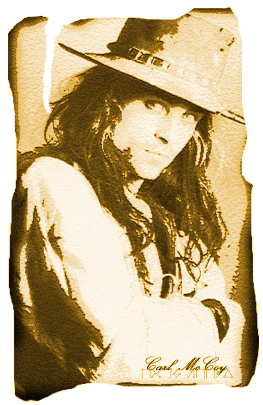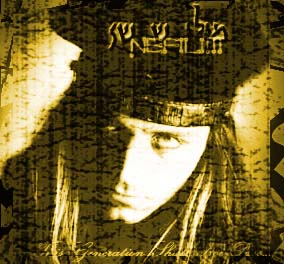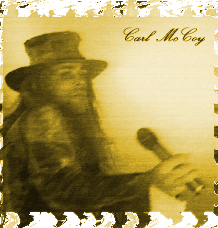|
The Monolithic Allure of THE NEPHILIM A look at the past and present through music. © Zoonshe images tweaked by Zoonshe
Fields of the Nephilim (1983-1991) Before the wonderful "spaghetti western" image/sound that permeated the Neffs early output, there was the self-released 1985 e.p. Burning the Fields. If you've never heard this release, it may surprise you for several reasons. The first being how raw and young vocalist Carl McCoy sounded at the time. Yes, there are those Andrew Eldritch type warbles in abundance especially during the wondrous Trees Come Down; (which has been reinvented twice since this original release. My favorite being the live version the band performed throughout 1987-early 1989). The drama in Carl's voice is very much evident, something that wouldn't return in a much more mature form until the glorious Last Exit for the Lost. It's during Trees... that we see the first hints of glory on the horizon. The musicians are surprisingly tight, as if they'd been playing together for more than the two years FotN had been around at that point. The early attempts at the smashing mix of melodic, catchy riffs laced with the menace that would dominate later recordings drifts in and out of the mix. I was skeptical about these early works because until '85 the band had a saxophone player in their midst, which just didn't work imo. While Burning the Fields is good, the second e.p. initially released in Italy, 1986's Returning to Gehenna is far superior. These songs made up the subsequent Power e.p., revealing the new direction of spaghetti western/Motorhead grit the band were experimenting with. This also features the one track with Gary Whisker's saxophone; The Tower-which is tough going mainly because of the out-of-place instrument. A note to completists; both of these e.p.s are packaged on one CD from Jungle Records as From Gehenna to Here. On the strength of their growing live performances, Beggar's Banquet snapped up Fields of the Nephilim for their offshoot label, Situation Two. The line up from here-on-in was: Carl McCoy- vocals (and keyboards in the studio), Tony Pettitt-bass, Nod Wright-Drums, his brother Paul Wright and Peter Yates on guitar.
One of the most attractive aspects of Fields of the Nephilim is how visual their music is. You see images strobing in your mind in tandem with the riffs, turbulent drums and suitably dark, seductive vocals. This ability to "see" was quite clearly in evidence on the band's first full length opus 1987's Dawnrazor. Unlike the early polished production of Burning the Fields, Dawnrazor is more mature musically, while sounding a heck of a lot more rough and tumble. This is what the band jokingly dubbed 'spaghetti metal'. This, in reference to their swarthy Leone-oat-opera style image. Although I can't describe what genre Fields of the Nephilim's music was, spaghetti metal certainly ISN'T it. Yes it was Gothic. Yes Carl's vocals traversed the plains of both Goth and Metal, and there was the undercurrent of metallic menace, but melody and quasi-funkiness too; (perhaps born from the reggae and funk roots of some members pre-Neffs musical endeavors). All this just makes it impossible to pigeonhole FoTN. Getting back to the tunage on Dawnrazor, the variety in the material shows just how creative and unafraid FoTN were. From the sinister, aching slow lurch of Vet for the Insane to more lively, all-out anthems like Preacher Man, the album had something for everyone. The mood would occasionally switch in the midst of a song as well. The Sequel is a good example of this. And for that, this song is one of my favorite numbers from Dawnrazor. The Sequel begins draped in great swatches of gothic finery with Carl asking if you'd cry more if he died, before the dreamy twin guitars and uptempo drums make the song switch from lamentation to an almost joyous number. Until, of course, a fade out into soundbites from Texas Chainsaw Massacre. Before Carl fully immersed himself in the various hoodoos of the mystic, the band were (and still remain) genre movie fans. A brilliant example of this perfect mesh of cinema and song is Dust. Dust is almost surely an ode to Sergio Leone's western epics like the bounty hunter themed wonder of For a Few Dollars More and the bands' apparent favorite, Once Upon A Time in the West. Everything about the song works wonderfully. Tony Pettitt's punk-style bass line is the spur-slapping the ground companion to McCoy's bullet-spitting voice, backed up by Noddy's rapid fire snare work. I lament on high that Dust wasn't chosen to be the video clip to sell the album as I think it perfectly fit the gunslinger image the band toyed with at the time. The title track Dawnrazor, is an incredibly powerful and menacing piece of work; a soundtrack to dreams and nightmares whose pummeling lingers long after the song ends. Another standout is the gleeful abandon of Reanimator featuring some of the delightful wailing's of Power-era McCoy, catchy riffs and another great Pettitt four string performance. The one song from Dawnrazor that seems lackluster to me is Volcane (Mr. Jealousy has Returned). Following Dawnrazor was the Blue Water e.p.. I grew to love Blue Water after seeing the video for the first time. Carl sings in his most gravel-like tone here, which works a creepy magic when paired with the music itself. It's the type of tune that Fields of the Nephilim excelled at in those days; melodic, smothered in that western sounding twang (a la Dawnrazor), but blunt and abrasive too. This version of Blue Water (Electrostatic) is the one from the 1993 Revelations comp. Stuck smack dab in the middle of the two takes of Blue Water is the cover of In Every Dream Home A Heartache. It's quite good. Serving as an early peek to the grand psychedelic style FoTN would formulate in about two years time. Like most of the early Neffs material, this cover showcases the guitars and bass; however the vocals were pushed to the back. This effect results in a dreamy composition. Blue Water (Hot Wire) is remarkably different from its more well known Electrostatic variant. While the song is the almost the same as the version we all know, the bass (yes!) is way up front, boasting a lot Less sustain on the guitars too. And the melodic strumming that Peter and Paul did throughout the Eletrostatic variant is kept to an abrupt minimum. I hear the riffs that stomp all over live versions much clearer in this take. Obviously a different mix, everything is up front and loud. I find this really cool because you focus on the entire band. My one regret is that this version isn't officially available on cd; after the first two listens, it's now my favorite variant of this wonderful ode to well, whatever McCoy is crooning about. Returning to the subject of the Dreamed version of Sumerland, the e.p. featuring this chestnut is a must find for anyone who loves the latter day FoTN. I immediately fell in love with this, largely due to the additional verses as song by McCoy and a nice instrumental bridge in the middle allowing the rest of FoTN (especially Tony) to shine. Nod, Peter and Paul also have strong moments here resulting in a truly fine showcase song for the band. This version of Sumerland evokes the spirit plain and the dream state more poignantly than it's album counterpart. Unforgettable, epic and memorable. I am pretty touchy with live albums. They have to be very special to earn my ear. For the most part I'd rather see the band live (that said, the audio for both official Neff concert videos are absolutely some of the best concert performances I've ever heard). Part of the reason why the official Earth Inferno live album doesn't hit me the way the audio for the Visionary Heads video does is due to the way this album was put together. The material is culled from three different gigs and the songs that Beggars chose weren't as fluid as the set the band actually performed. In addition the sound fluctuated noticeably which is a sore point. The incredibly tranquil vibe of the Elizium material is best broken up with FoTN's more uptempo songs which isn't present here. Still, Earth Inferno does have some a few choice moments. Psychonaut is amazing live, while Moonchild retains the delight and fun that its always been. Dawnrazor closes the disc on a great note. A good live release, but Beggars Banquet could have released a more well-rounded live album than this. It's a shame to end the era of the original FotN with a decent rather than amazing live album, because the band were more a lot more than the sum of this disc's parts.
THE NEPHILIM (1998-Present)
Since the release of the unofficial mess that was Fallen, Carl flipped the bird to Jungle records taking matters into his own hands. He will be self releasing all future Nephilim material with as yet unknown musicians. I wish him luck and will continue to support this talented dark maestro in whatever form his musical and artistic endeavors take. |

 The
first release for Beggars was the Power
e.p.; a slightly remixed version of the
songs on Returning to Gehenna. These
tunes are a upbeat mash of punkish enthusiasm
and melodrama that early Nephilim output
had in abundance. It wasn't quite the intricate
rough and tumble that would follow. I am still ga-ga over Secrets (hear how low
Carl's abyss-deep vocals can go). Secrets
is hard to describe musically, but it's
one of those songs I play to lift my spirits
up. McCoy's emotional vocals make the hook-laden
riffs and bouncy drumwork spark, resulting
in something close to anthem material. Where
else would you be tempted to sing and dance
to a quote from Jesus Christ himself? (I
forgive you, follow me.) There is
a dynamic vibe to this song hinting at the
mythos to come. Power is another
one of those anthem-like tunes the band
excelled at. Note: This e.p. is
now on two cds; the From Gehenna to Here
release from Jungle Records, and Beggar's
1997 re-release of Dawnrazor.
The
first release for Beggars was the Power
e.p.; a slightly remixed version of the
songs on Returning to Gehenna. These
tunes are a upbeat mash of punkish enthusiasm
and melodrama that early Nephilim output
had in abundance. It wasn't quite the intricate
rough and tumble that would follow. I am still ga-ga over Secrets (hear how low
Carl's abyss-deep vocals can go). Secrets
is hard to describe musically, but it's
one of those songs I play to lift my spirits
up. McCoy's emotional vocals make the hook-laden
riffs and bouncy drumwork spark, resulting
in something close to anthem material. Where
else would you be tempted to sing and dance
to a quote from Jesus Christ himself? (I
forgive you, follow me.) There is
a dynamic vibe to this song hinting at the
mythos to come. Power is another
one of those anthem-like tunes the band
excelled at. Note: This e.p. is
now on two cds; the From Gehenna to Here
release from Jungle Records, and Beggar's
1997 re-release of Dawnrazor.  After
Carl McCoy left FoTN in 1991, he
proceeded to put together a new band
to channel his much pent up anger
and aggression. This was the NEFILIM.
McCoy-who long admitted to being attracted
to the extreme end of the music spectrum-delivered
his own lethal stab at gothic, industrial-fused
death metal in the form of 1996's
Zoon. Many longtime Neffs fans
were left in the cold, horrified that
their beloved shaman took a nose dive
into the black and heady waters of
Metal. Ahem. Upon giving my ears over
to this, yours truly all but crapped
her pants. Zoon was the second
release I'd heard on the heels of
Elizium and it just blew me
away. McCoy's vocals are nothing short
of incredible on this album; proving
the almost operatic delivery and range
the man can deliver given the chance
to cut loose. Something was missing
towards the end of the Neffs existence,
and watching early performances of
FoTN with the latter day variant
leads me to believe the rawness and
vibrancy the band had in the beginning
got lost somewhere. Carl reclaimed
that power and menace on Zoon
to an extent. As mentioned above,
his vocals are the selling bludgeon
of this album, the sometimes lackluster
musicians behind McCoy really made
you notice how close yet so far The
Nefilim were in their potency.
After
Carl McCoy left FoTN in 1991, he
proceeded to put together a new band
to channel his much pent up anger
and aggression. This was the NEFILIM.
McCoy-who long admitted to being attracted
to the extreme end of the music spectrum-delivered
his own lethal stab at gothic, industrial-fused
death metal in the form of 1996's
Zoon. Many longtime Neffs fans
were left in the cold, horrified that
their beloved shaman took a nose dive
into the black and heady waters of
Metal. Ahem. Upon giving my ears over
to this, yours truly all but crapped
her pants. Zoon was the second
release I'd heard on the heels of
Elizium and it just blew me
away. McCoy's vocals are nothing short
of incredible on this album; proving
the almost operatic delivery and range
the man can deliver given the chance
to cut loose. Something was missing
towards the end of the Neffs existence,
and watching early performances of
FoTN with the latter day variant
leads me to believe the rawness and
vibrancy the band had in the beginning
got lost somewhere. Carl reclaimed
that power and menace on Zoon
to an extent. As mentioned above,
his vocals are the selling bludgeon
of this album, the sometimes lackluster
musicians behind McCoy really made
you notice how close yet so far The
Nefilim were in their potency. If
I'm to understand the mechanics around the
One More Nightmare single which McCoy
and Pettitt quietly released in 2000, this
was actually laid down during 1998 which
would mean the Wright brothers were involved
in the recording. Everything that was so
great about the ancient FoTN song Trees
Come Down-now reborn as One More
Nightmare (Trees Come Down AD) remains:
the terrific hook-laden main riff, thumping
drums, up front vocals all have been pushed
waaaaay over the edge here. McCoy's harsh,
E-V-I-L wailing's are perfect over the relentlessly
catchy guitar. Those blistering tones sound
akin to one being ravaged by horrid forces
then embracing whatever awful powers these
might be. The roar of "This dying age!"
takes on a whole new dimension here. In
stark, wonderful contrast to this is the
new version of Darkcell( AD). It
easily matches some of FoTN's quieter moments,
while never letting you forget something
dark is going on. Also this version far
surpasses the almost new wavish original
that was on Burning the Fields. McCoy's
pillow talk vocals just floor me.
If
I'm to understand the mechanics around the
One More Nightmare single which McCoy
and Pettitt quietly released in 2000, this
was actually laid down during 1998 which
would mean the Wright brothers were involved
in the recording. Everything that was so
great about the ancient FoTN song Trees
Come Down-now reborn as One More
Nightmare (Trees Come Down AD) remains:
the terrific hook-laden main riff, thumping
drums, up front vocals all have been pushed
waaaaay over the edge here. McCoy's harsh,
E-V-I-L wailing's are perfect over the relentlessly
catchy guitar. Those blistering tones sound
akin to one being ravaged by horrid forces
then embracing whatever awful powers these
might be. The roar of "This dying age!"
takes on a whole new dimension here. In
stark, wonderful contrast to this is the
new version of Darkcell( AD). It
easily matches some of FoTN's quieter moments,
while never letting you forget something
dark is going on. Also this version far
surpasses the almost new wavish original
that was on Burning the Fields. McCoy's
pillow talk vocals just floor me.